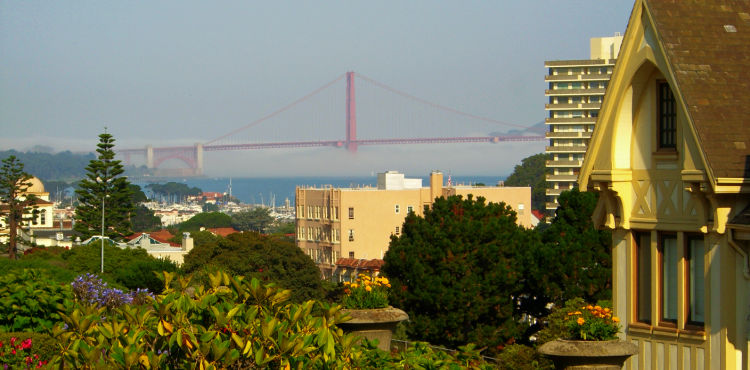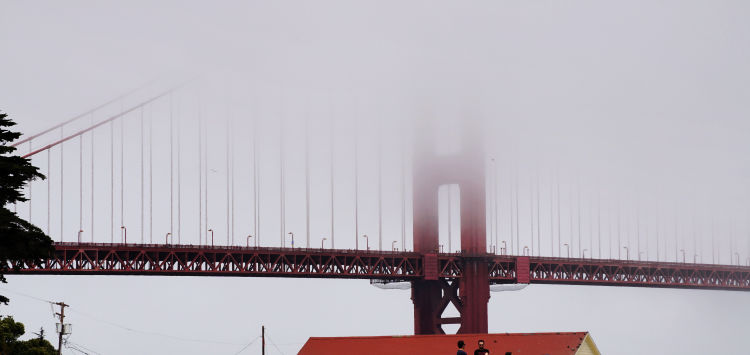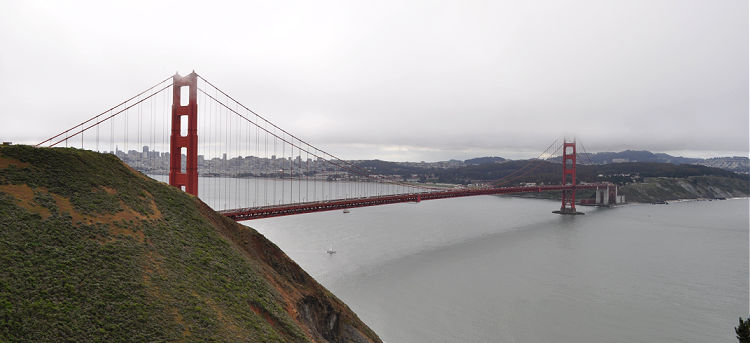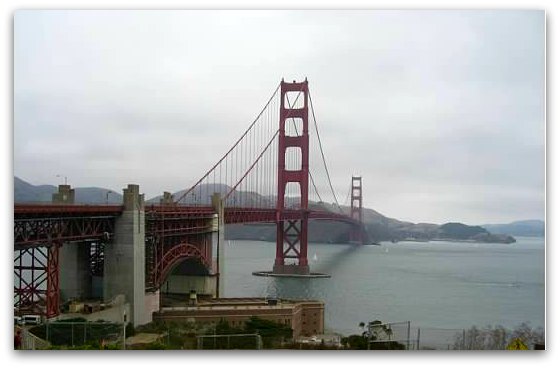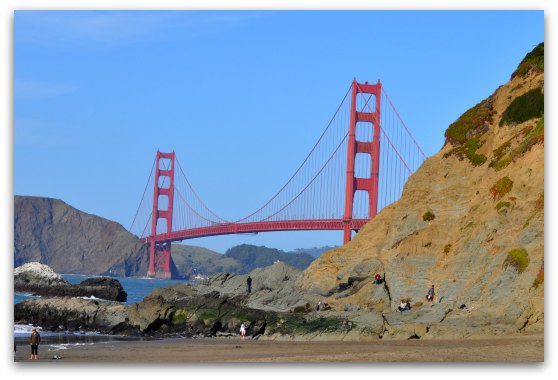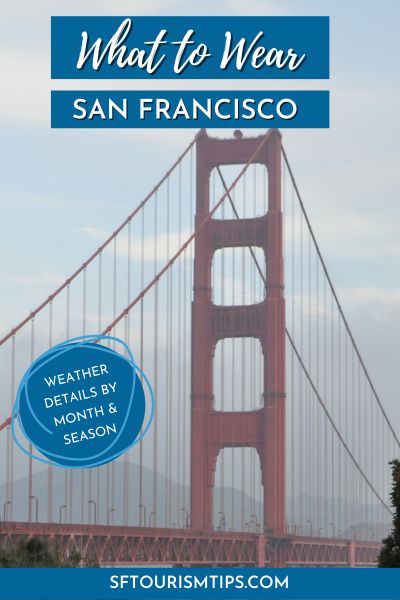SIGN UP FOR MY EMAIL TO RECEIVE YOUR FREE SAN FRANCISCO PLANNING GUIDE.
- Home
- Plan Your Visit
- Weather & What to Wear
Weather in San Francisco CA & What to Wear
by Jill Loeffler •
Many people are caught off guard by the weather in San Francisco, CA. We have a unique climate here. It is typically much cooler than the rest of California.
Some days, you will find a bright blue, clear sky. On other days, you will find it partly cloudy. You will also find days when we are covered in fog.
The pictures below give you an idea of the different types of weather you can expect in SF. There are certain times of the year when each is more common.
Read on to find out more about when it's the clearest, when it's the foggiest, and what else to expect each month of the year.
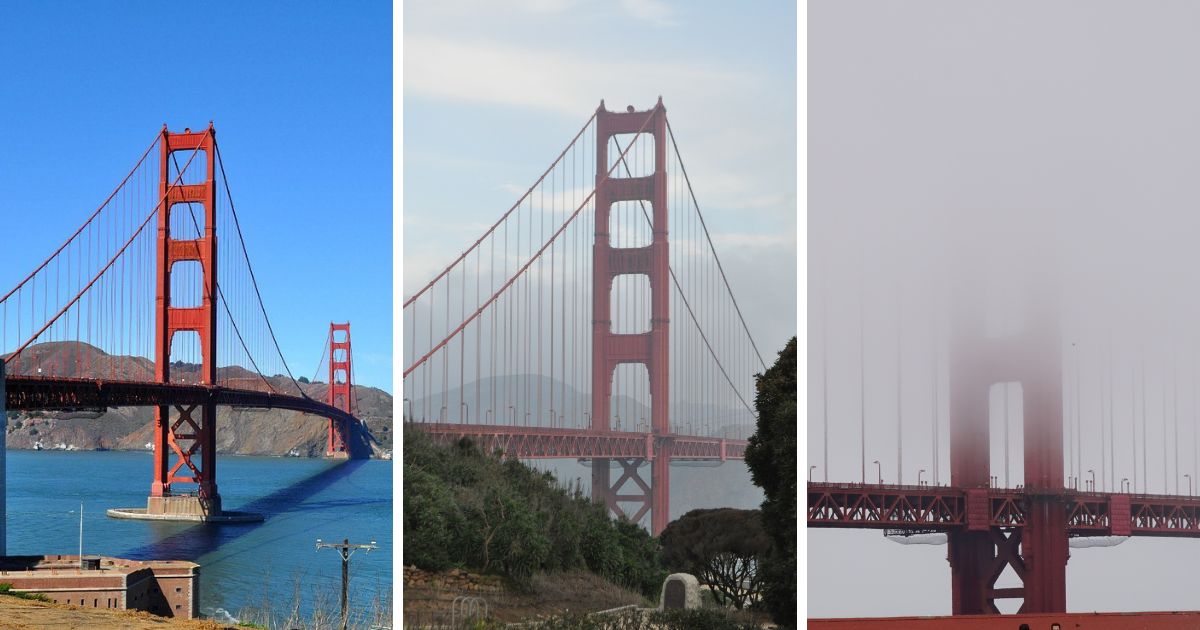 I took all three of these pictures at similar locations near the Golden Gate Bridge. It gives you an idea of our changing weather throughout the year.
I took all three of these pictures at similar locations near the Golden Gate Bridge. It gives you an idea of our changing weather throughout the year.Why is San Francisco Cold All the Time?
The city is actually a peninsula, surrounded on three sides by cool water where the Pacific Ocean on the west meets the bay on the east. When warm air mixes with this cool water, it creates fog.
This is what we like to refer to as our 'natural air-conditioning'! It keeps the city at a comfortable, even temperature throughout the year.
I'm sure you've heard the following quote attributed to Mark Twain:
"The coldest winter I ever spent was a summer in San Francisco."
Although we now know he didn't say this, the quote has become synonymous with our year-round cool temperatures. Yes, even in the summer!
In the picture below, you can see the clear day with the fog starting to roll in under the Golden Gate Bridge. The hazy look of the bridge is also due to the fog.
We also get quite a bit of wind, which blows in from the Pacific Ocean.
It isn't windy every day, but it's one more San Francisco weather factor that keeps the city cool most of the year.
SFTourismTips is made possible by readers like you! If you book through my links, I may earn a small commission at no extra cost to you. Thanks for your support! Learn more.
San Francisco Fog Seasons
Although fog is characteristic of San Francisco weather, it isn't foggy here all of the time. So what are the San Francisco fog seasons?
There are two: summer and winter. Each fog season is different, as the fog is created by a distinct type of weather pattern. Read on for more details.
Summer Fog in San Francisco
Our summer fog is dense and beautiful. This is the fog that is often written about and photographed.
The summer fog, officially known as advection fog, typically hangs over the city in the mornings, burns off throughout the day, and then floats back into the city in the evenings from the Pacific Ocean.
The picture above shows you how thick it can get in the summer. I took this while I was on the western end of Crissy Field, having a picnic with friends.
The Golden Gate Bridge is less than a half mile away, and there is so much fog you can barely see it!
Winter Fog in San Francisco
The winter fog in San Francisco, known as tule fog, isn't as thick and doesn't get the press that our summer fog gets.
In fact, it's often confused with regular cloud cover, as it doesn't always dip down as low over the city and lacks the beautiful "billowing" effect.
That's because, rather than coming in under the Golden Gate Bridge from the ocean, this type of fog comes from the inland regions to the east, and can last for days or weeks at a time.
It coincides with our rainy season, and you will find it anytime between the end of November and early March.
In the picture above, which I took in early April from the Marin Headlands on the northern end of the Golden Gate Bridge, you'll notice the difference between winter and summer fog.
Fun Fact: San Francisco is NOT the foggiest place in the world. It isn't even the foggiest place in the US. That designation goes to Cape Disappointment in Washington.
San Francisco Microclimates
San Francisco is also known as the city built on seven hills.
These hills and valleys, combined with the fog, wind, and surrounding water, are the reason for San Francisco's microclimate—pockets of the city that can vary greatly in temperature, up to 15 degrees from one district to the next!
That means, even if it's warm and sunny in Union Square, it might be foggy and windy in Golden Gate Park at the same exact time.
This is one of the reasons I recommend wearing layers throughout your stay: you can easily add or remove pieces as you move from neighborhood to neighborhood (or sometimes just a few blocks in from the waterfront)!
What to Expect in Certain Areas of the City
The eastern side of San Francisco is where you will find Union Square, downtown San Francisco, and North Beach. This is where you will find more sunny and partly cloudy days, as it's further from the Pacific Ocean.
Fisherman's Wharf is on the northeastern end of San Francisco. It's a bit cooler here from the breezes off the water and gets a little more fog than the inland districts. However, it doesn't get as much fog as the western end of San Francisco.
The western end, including the Golden Gate Park and the Sunset District, is where you will find the most fog. This is where the city meets the Pacific Ocean. The cool breezes off the water create more fog out here and keep this section of the city quite a bit cooler.
Certain districts, like the Mission District and Noe Valley, get quite a bit of sun and tend to be warmer than other districts just up the street from it, since Twin Peaks to its west blocks some of the fog.
San Francisco Weather Averages by Month
Here is a monthly breakdown of the weather in San Francisco, CA. As you can see from the table below, the temperature doesn't change much throughout the year, making this city one of the most desirable places to live!
This list offers the average highs and lows in Fahrenheit by month. The equivalent in Celsius is in parentheses.
- January: High 57o (14o), Low 46o (8o)
- February: High 61o (16o), Low 48o (9o)
- March: High 62o (17o), Low 49o (9o)
- April: High 64o (18o), Low 51o (10o)
- June: High 67o (18o), Low 53o (11o)
- July: High 67o (19o), Low 54o (12o)
- August: High 69o (20o), Low 56o (13o)
- September: High 71o (22o), Low 56o (13o)
- October: High 69o (21o), Low 54o (12o)
- November: High 64o (18o), Low 51o (11o)
- December: High 57o (14o), Low 46o (8o)
What to Wear: By Season & Month
I often get asked, "What should you wear in the cool weather in San Francisco, CA?" Here you will find a few tips to help you pack the right clothes for your San Francisco vacation.
Mostly, it boils down to one word: layers!
By layering your clothing, you can add and remove pieces as necessary. I always bring along a light sweater or jacket whenever I go out (yes, even in the summer!) so I can warm up or cool down if needed.
SF is a very casual place, so you can wear jeans or casual clothes to almost any event, restaurant, or bar. After all, Levi Strauss invented jeans here, so we don't often break from that tradition!
TIP: You will find some higher-end restaurants or special events that require smart casual or business casual dress. Not to worry, though, I will keep you aware of those details in the descriptions on my events pages. You will know if you need to pack something a little dressier.
This section provides a more detailed look—by season and month—to help you pack for your trip.
Click any of the links below to skip ahead to a specific time of year.
If you already know what month you will be visiting, you can head straight to my dedicated monthly weather pages below. Here you will find quite a bit more detail about what to expect that month as well as some tips on what to wear!
Click the links below to learn more for the specific month you are visiting!
SF in the Fall: September and October
This is my favorite time of the year in San Francisco because the weather is sunny and beautiful. The average daily highs are around 70 with lows at night in the mid-50s, and it is rarely foggy.
During this time, I typically wear a short-sleeved shirt and carry a light sweater. At night, I will add a light jacket—and sometimes move to close-toed shoes to stay warmer.
This is the best time of year to wear a skirt and sometimes even shorts. However, make sure you have plenty of long pants or jeans, too.
>> Find out more about why I think this is the best time to visit
SF Spring Weather: April and May
We usually just have two months of 'spring weather,' as April and May are nice and sunny. You will find temps in the mid-60s during the day and mid-50s at night.
A short-sleeved shirt, along with a light sweater or jacket, is your best bet during the day. You should also bring along a warmer sweater or jacket at night. Layering is key, so you can add and remove items throughout the day.
SF Summer Weather: June, July & August
These three months are the hardest to understand since the weather forecast and average temperatures can be deceiving.
Looking at the temperatures, you will see the average highs in the upper 60s and lows in the mid-50s. Perfect, right? Yes and no.
While the weather is still beautiful this time of year, it can change quite a bit from one day to the next due to the fog. One day it might be 75, sunny and gorgeous—and then the next day, you might wake up to fog, wind, and temps around 55.
The other thing that happens during these months is that the temperature fluctuates throughout the day. Even if you wake up to fog, it might burn off during the day and warm up quite a bit. Or the reverse—you might wake up to a sunny, warm morning and then get chilly in the late afternoon when the fog and wind start to roll in for the night.
During these months, it's important to pack several items that you can layer. Here are a few things you should bring along during these months:
- A couple of lightweight, long-sleeve or 3/4 sleeve shirts
- A couple of short-sleeved shirts
- One or two lightweight sweaters
- A lightweight jacket
- At least one pair of close-toed shoes
- Long pants and skirts
- Windbreaker you can store in your daypack (see some examples of these on Amazon)
Make sure you can mix and match everything above. This allows you to move your clothes around if it's warmer or cooler than expected on any given day.
If you are often cold like me, then you can leave the shorts at home.
This is a picture I took during a foggy summer day. It looks like it's going to rain, but it's just a heavy layer of fog over the Golden Gate Bridge.
This is another picture I took around the same time of year. As you can see, even if it's foggy one day, the next might be clear and sunny!
Winter Months: November to March
November to March is our rainy season, when temperatures are slightly cooler. During the day, the temperatures hover around 60. At night, they drop down to around 50—and some nights even colder.
You will want to bring along medium-weight shirts, sweaters, and at least one jacket. Again, this allows you to layer, as the temps can be different from day to day.
You will also want to prepare for the rain. We get a light rain that is easy to walk in, but might last all day. We rarely have thunderstorms, and it's not very common for us to get downpours.
Your best option is to bring along a medium-weight raincoat that you can wear all the time, and—only if you don't mind carrying it around—an umbrella if you want to stay completely dry.
NOTE: Our rain is usually light and steady and won't interfere with your plans to get out and see the sights. However, in recent years, we have been getting the occasional atmospheric river, which can bring a few days of heavy rain and high winds. It's always a good idea to check the weather forecast before you travel and have a Plan B just in case. Consider these fantastic indoor activities in San Francisco.
Here are some examples of the lighter sweaters and jackets that work almost any time of year for the weather in San Francisco, CA:
San Francisco Bay Weather
Looking online at the weather for San Francisco, CA is a little deceiving. To ensure the most accurate forecast, select a location directly in San Francisco.
If you're checking the weather at the SFO airport (the default location for most SF weather sites), it will likely show a warmer or cooler temperature than the city itself. SFO is warmer in the summer and slightly cooler in the winter.
To get the most accurate San Francisco weather forecast, type in a specific zip code such as 94133 (Fisherman's Wharf) or 94102 (Union Square). This will pinpoint the temperature in the area of the city you are visiting.
If you are watching the weather forecast on TV, you will notice that there are three different temperature zones.
Pacific Ocean Temperatures
This is for the areas in San Francisco that are near the ocean, including Ocean Beach, Golden Gate Park, and the Presidio.
SF Bay Temperatures
This is for the eastern half of SF and locations just north and east of San Francisco along the bay. These temperatures are usually about 10 to 15 degrees warmer than in the city itself.
Areas that apply include Fisherman's Wharf, Alcatraz, and other sites on the east side of San Francisco, as well as the surrounding cities of Berkeley, Oakland, Sausalito, and Tiburon.
Inland Area Temperatures
The inland area temperatures are for Bay Area cities that are not along the water. These are usually about 35 to 40 degrees warmer than SF in the summer. In the winter, they can be up to 20 to 25 degrees cooler.
These are for those visiting San Jose, Santa Rosa, and areas to the east, such as Walnut Creek. There is a wide variation in temperatures based on location.
How does San Francisco weather compare to the weather over in Oakland? San Francisco stays a cool 60 or so degrees all year long. Oakland is slightly warmer in the summer and about the same in the winter. In Oakland, you will find higher temperatures in the summer months (70 to 75) and about the same temperatures in the winter months (58 to 61). At night, the temperatures are similar, with only about 1 to 2 degrees difference from San Francisco's weather.
How does San Francisco weather compare to San Jose weather? The weather in San Jose is warmer than in SF. Temps are fairly consistent between these two cities from November to February. The rest of the year, the San Jose weather is warmer. You will find temps up into the 80s from June through September, but still cooling down into the upper 50s at night.

Hi, I’m Jill!
I’ve been sharing San Francisco travel advice since 2009 and have helped millions of people explore the city like a local. Whether you’re dreaming of sea lions, cable cars, or a great sourdough bread bowl, I’m here to help you plan an unforgettable trip with real tips from someone who actually lives here.
Comments? Questions? Suggestions?
I would love for you to join me in my private Facebook group!
It's a great place to interact with me and others who are familiar with the area.
You can ask questions, get advice for your upcoming stay, and then share your photos and advice with others when you return home. It's a great community and the fastest way to get answers to those nagging questions about your visit!
